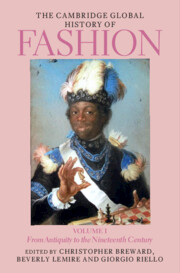Book contents
- The Cambridge Global History of Fashion
- The Cambridge Global History of Fashion
- The Cambridge Global History of Fashion
- Copyright page
- Contents for Volume I
- Figures for Volume I
- Maps for Volume I
- Table for Volume I
- Contributors for Volume I
- Preface
- 1 Global History in the History of Fashion
- Part I Multiple Origins of Fashion
- Part II Early Modern Global Entanglements
- Part III Many Worlds of Fashion
- 13 ‘Black Cloth’
- 14 Fashion and Moral Concern in Early Modern Japan
- 15 Textiles and Fashion in Southeast Asia
- 16 Fashion in Ming and Qing China
- 17 Everyday Fashion in the Ottoman Empire,C. 1600–1800
- 18 Imperialism and Fashion: South Asia, c. 1500–1800
- 19 Fashion Systems in the Indian Ocean World, from Ancient Times to c. 1850
- 20 Fashion and First Peoples in European Settler Societies, c. 1700–1850
- Index
- References
19 - Fashion Systems in the Indian Ocean World, from Ancient Times to c. 1850
from Part III - Many Worlds of Fashion
Published online by Cambridge University Press: 04 August 2023
- The Cambridge Global History of Fashion
- The Cambridge Global History of Fashion
- The Cambridge Global History of Fashion
- Copyright page
- Contents for Volume I
- Figures for Volume I
- Maps for Volume I
- Table for Volume I
- Contributors for Volume I
- Preface
- 1 Global History in the History of Fashion
- Part I Multiple Origins of Fashion
- Part II Early Modern Global Entanglements
- Part III Many Worlds of Fashion
- 13 ‘Black Cloth’
- 14 Fashion and Moral Concern in Early Modern Japan
- 15 Textiles and Fashion in Southeast Asia
- 16 Fashion in Ming and Qing China
- 17 Everyday Fashion in the Ottoman Empire,C. 1600–1800
- 18 Imperialism and Fashion: South Asia, c. 1500–1800
- 19 Fashion Systems in the Indian Ocean World, from Ancient Times to c. 1850
- 20 Fashion and First Peoples in European Settler Societies, c. 1700–1850
- Index
- References
Summary
In his pioneering studies on the longue durée in the Indian Ocean world, K. N. Chaudhuri stressed the dynamism of dress in this vast region, finding in some instances ‘all the ingredients for high fashion’.1 He forcefully argued for revising Fernand Braudel’s earlier conclusions, based on studies of the greater Mediterranean, that fashion originated in (and was exclusive to) Europe.2 Although not immediately ‘intelligible or accessible to outsiders’, wrote Chaudhuri, the ‘dress habits of the people of the Indian Ocean changed’.3 The basic garment shape or silhouette might endure over time, but those-in-the-know gauged fashionability in subtle modifications of cut, length, pleating, and, above all, in details of fibre, fabric, and ornamentation. Sumptuary laws and cultural norms strongly guided garment choice in many times and places, but even so, dress was continually modified as a powerful signifier of status and allegiance, further open to ‘expressions of individual tastes and preferences’.4
- Type
- Chapter
- Information
- The Cambridge Global History of FashionFrom Antiquity to the Nineteenth Century, pp. 630 - 671Publisher: Cambridge University PressPrint publication year: 2023



